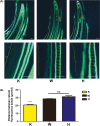The role and potential mechanism of p75NTR in mineralization via in vivo p75NTR knockout mice and in vitro ectomesenchymal stem cells
- PMID: 31922317
- PMCID: PMC7048213
- DOI: 10.1111/cpr.12758
The role and potential mechanism of p75NTR in mineralization via in vivo p75NTR knockout mice and in vitro ectomesenchymal stem cells
Abstract
Objective: The aim of this study is to investigate the role and potential mechanism of p75NTR in mineralization in vivo using p75NTR-knockout mice and in vitro using ectomesenchymal stem cells (EMSCs).
Materials and methods: Femur bone mass and daily incisor mineralization speed were assessed in an in vivo p75NTR-knockout mouse model. The molecular signatures alkaline phosphatase (ALP), collagen type 1 (Col1), melanoma-associated antigen (Mage)-D1, bone sialoprotein (BSP), osteocalcin (OCN), osteopontin (OPN), distal-less homeobox 1 (Dlx1) and Msh homeobox 1 (Msx1) were examined in vitro in EMSCs isolated from p75NTR+/+ and p75NTRExIII-/- mice.
Results: p75NTR-knockout mice were smaller in body size than heterozygous and wild-type mice. Micro-computed tomography and structural quantification showed that the osteogenic ability of p75NTRExIII -knockout mice was significantly decreased compared with that of wild-type mice (P < .05). Weaker ALP and alizarin red staining and reduced expression of ALP, Col1, Runx2, BSP, OCN and OPN were also observed in p75NTRExIII-/- EMSCs. Moreover, the distance between calcein fluorescence bands in p75NTRExIII -knockout mice was significantly smaller than that in wild type and heterozygous mice (P < .05), indicating the lower daily mineralization speed of incisors in p75NTRExIII -knockout mice. Further investigation revealed a positive correlation between p75NTR and Mage-D1, Dlx1, and Msx1.
Conclusion: p75NTR not only promotes osteogenic differentiation and tissue mineralization, but also shows a possible relationship with the circadian rhythm of dental hard tissue formation.
Keywords: ectomesenchymal stem cells; knockout mice; mineralization; p75 neurotrophin receptor; tooth.
© 2020 The Authors. Cell Proliferation Published by John Wiley & Sons Ltd.
Conflict of interest statement
All authors declare that they have no competing interests.
Figures







References
-
- Barker PA. p75NTR is positively promiscuous: novel partners and new insights. Neuron. 2004;42:529‐533. - PubMed
-
- Nalbandian A, Pang AL, Rennert OM, Chan WY, Ravindranath N, Djakiew D. A novel function of differentiation revealed by cDNA microarray profiling of p75NTR‐regulated gene expression. Differentiation. 2005;73:385‐396. - PubMed
-
- Nie X, Xing Y, Deng M, et al. Ecto‐mesenchymal stem cells from facial process: potential for muscle regeneration. Cell Biochem Biophys. 2014;70:615‐622. - PubMed
MeSH terms
Substances
Associated data
- Actions
- Actions
- Actions
- Actions
- Actions
- Actions
- Actions
Grants and funding
LinkOut - more resources
Full Text Sources
Molecular Biology Databases
Research Materials

